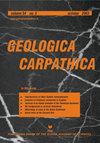弯曲海侵开始时的前陆状态:来自喀尔巴阡山脉边缘前深(捷克)物源分析的数据
IF 1.5
4区 地球科学
Q4 GEOSCIENCES, MULTIDISCIPLINARY
引用次数: 1
摘要
在Znojmo的NE-SE封闭区域发现的Žerotice组是捷克共和国摩拉维亚喀尔巴阡前深西南边缘沉积序列的一个基础成员。在地层中发现了两种相组合。第一个层盖在前新近纪基底上,具有不规则不整合,反映了干旱气候条件和幕式浅层高能量流和(或)块状流(冲积到河流沉积)的沉积。第二种相组合被解释为泻湖至远端洪泛平原沉积。Žerotice组的贫瘠非化石矿床被近岸海相埃根伯格矿床所覆盖。这些矿床之间的边界代表一个层序边界(即基底前隆起不整合)。对层序边界上下连续层的详细物源研究表明,源区和古水系存在差异。当地原生结晶岩(摩拉维亚和摩尔多瑙河单元,塔亚基)和更古老的沉积盖层(特别是二叠-石炭系沉积岩)构成了Žerotice组的物源。所有这些地质单元都位于距离Žerotice组沉积保存区域范围仅几公里的地方(短途运输和当地来源)。上覆海相埃根堡地层的源区位于摩尔多瓦和摩拉维亚单元的远偏西和西北(较长的运输,延伸的源区)。初步解释了Žerotice组局部受限的保存与构造倾向的古谷有关。本文章由计算机程序翻译,如有差异,请以英文原文为准。
The foreland state at the onset of the flexurally induced transgression: data from provenance analysis at the peripheral Carpathian Foredeep (Czech Republic)
Abstract The Žerotice Formation recognised in a confined area NE–SE of Znojmo represents a basal member of the sedimentary succession of the southwestern margin of the Carpathian Foredeep in Moravia (Czech Republic). Two facies associations were recognised within the formation. The first one mantles the pre-Neogene basement with an irregular unconformity, reflects arid climatic conditions and deposition of episodic shallow, high-energy stream flows and/or mass flows (alluvial to fluvial deposits). The second facies association is interpreted as lagoonal to distal flood plain deposits. The barren unfossiliferous deposits of the Žerotice Formation are covered by nearshore marine Eggenburgian deposits. The boundary between these deposits represents a sequence boundary (i.e. the basal forebulge unconformity). Detailed provenance studies of successive beds below and above this sequence boundary showed differences in the source area and paleodrainage. Both the local primary crystalline rocks (Moravian and Moldanubian Unit, Thaya Batholith) and older sedimentary cover (especially Permo–Carboniferous sedimentary rocks) form the source of the Žerotice Formation. All these geological units are located only a few km away from the preserved areal extent of the deposits of the Žerotice Formation (short transport and a local source). The source areas of the overlying marine Eggenburgian beds are located far more to the W and NW in the Moldanubian and Moravian Units (longer transport, extended source area). Local confined preservation of the Žerotice Formation is preliminarily explained as connected with a tectonically predisposed paleovalley.
求助全文
通过发布文献求助,成功后即可免费获取论文全文。
去求助
来源期刊

Geologica Carpathica
地学-地球科学综合
CiteScore
2.40
自引率
23.10%
发文量
26
审稿时长
>12 weeks
期刊介绍:
GEOLOGICA CARPATHICA covers a wide spectrum of geological disciplines including geodynamics, tectonics and structural geology, volcanology, stratigraphy, geochronology and isotopic geology, karstology, geochemistry, mineralogy, petrology, lithology and sedimentology, paleogeography, paleoecology, paleobiology and paleontology, paleomagnetism, magnetostratigraphy and other branches of applied geophysics, economic and environmental geology, experimental and theoretical geoscientific studies. Geologica Carpathica , with its 60 year old tradition, presents high-quality research papers devoted to all aspects not only of the Alpine-Carpathian-Balkanian geoscience but also with adjacent regions originated from the Mediterranean Tethys and its continental foreland. Geologica Carpathica is an Official Journal of the Carpathian-Balkan Geological Association.
 求助内容:
求助内容: 应助结果提醒方式:
应助结果提醒方式:


